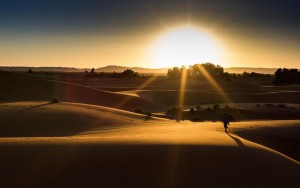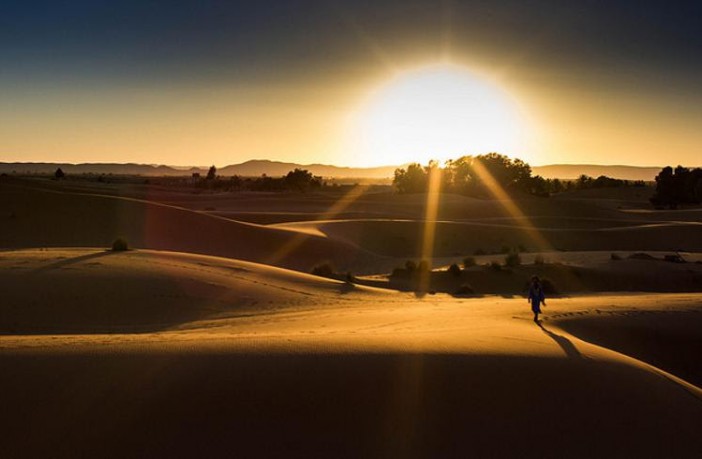SeeNews Renewables
by Mariyana Yaneva

Morocco last week inaugurated the 160-MW Noor I concentrating solar power (CSP) as the first phase of what would be the world’s largest facility of the kind. Yet, many questions remain over the future of the project.
FACTS AND FIGURES
A total of 500,000 twelve-metre-high curved mirrors now spread over a surface of 480 hectares near the trading city of Ouarzazate, nicknamed the “door of the desert”.
The thermosolar cylindrical parabolic troughs are coupled with three hours of energy storage capability and the annual output of about 500 GWh of solar power is estimated to supply the needs of over 700,000 local homes.
Constructing this first,160-MW phase took 30 months, starting in May 2013. Over 2,000 people, 1,800 of whom from Morocco, were employed.
The overall investment is valued at between MAD 6.3 billion (USD 652m/EUR 577m) and MAD 8 billion (USD 826m/EUR 734m), according to different information in Moroccan media, while the contracted power purchase price is MAD 1.6 (USD 0.159/EUR 0.150) per kWh.
The EUR-810-million second phase Noor II will also use thermosolar cylindrical parabolic troughs which will spread over an area of 680 hectares. The plant will have a nameplate capacity of 200 MW, coupled with seven hours of energy storage capability. It will sell its electricity output at MAD 1.36 per kWh.
The third phase — Noor III, will spread on an area of 750 hectares. It will have an installed capacity of 150 MW but it will employ a different CSP technology — a central tower with salt receivers, plus seven to eight hours of energy storage capability. It will sell power at MAD 1.42 per kWh while construction costs have been estimated at EUR 645 million.
The last phase of the complex — Noor IV, will be developed on a surface of 210 hectares with photovoltaic (PV) technology. It will have a minimum capacity of 70 MW.
When all four phases are completed the Ouarzazate complex will be the world’s largest multi-technology solar power plant with 580 MW of nameplate capacity and an overall investment of more than MAD 24 billion.
The launch of construction works for the second and third phase of the mega project took place immediately after the inauguration of the first.
Noor II and Noor III are expected to start producing electricity in 2018.
WHO ARE THE BUILDERS?
The development and operation of Noor I, II and III was entrusted to a consortium led by Saudi Arabian Acwa Power and including also Spanish Sener, Acciona and TSK Electronica y Electricidad.
Under a build, own, operate and transfer (BOOT) scheme, a special purpose vehicle was set up under the name of Acwa Power Ouarzazate, which is 75% owned by Acwa Power and 25% controlled by Moroccan agency for solar power Masen.
Spanish Sener announced it is now beginning the works on Noor II, in which Sener’s second generation of parabolic troughs – the Senertrough®-2 system – are being installed.
A larger heliostat, designed and manufactured by Sener, will be used in Noor III, in the same configuration as in the successfully applied Gemasolar plant in Seville (Spain).
WHERE DOES THE MONEY COME FROM?
Funding for the Noor I, II and III is raised through a public-private partnership arrangement that brings together Masen, the African Development Bank, the World Bank, the Clean Technology Fund (part of Climate Investment Funds), the European Investment Bank, the KfW Development Bank, the French Development Agency, and private operators. There is also a significant grant from the European Union.
The overall project cost for Noor I through III, excluding taxes and customs duties is estimated at EUR 2.105 billion, according to data published by the African Development Bank.
The funds loaned to Masen by financial partners are reassigned to three project companies for each of the three plants. Each project company is owned by a private consortium selected following a tender process (75%) and Masen (25%). The latter will be the single buyer of the electricity generated by the plants.
To spur and support the phased development of the Noor CSP complex, USD 435 million in concessional funding from the Climate Investment Funds Clean Technology Fund was channeled through the African Development Bank and World Bank.
Noor II and III will be backed by European funds to the tune of MAD 17 billion or 60% of the total funding for the three CSP power plants.
Given the scale of public finance required to subsidize this multi-billion, multi-phase complex, the support of both MDBs and the CIF was critical.
Ultimately financed with 80% debt and 20% equity, CIF lending helped to reduce the project’s energy costs by 25% for Noor I and an additional 10% for Noor II and III (achieved in 2015), thus reducing the government subsidy required to bridge the affordability gap for CSP.
WHAT HIDES IN THE SHADOW?
Most analysts agree that the choice of CSP technology at the Ouarzazate complex was motivated by the desire to have power round the clock and optimise electricity generation to help cover the peak demand which occurs between 17:00 and 22:00 in winter and 18:00 and 23:00 in summer.
Recent advances in energy storage technologies coupled with the declining cost of PV are raising the question if these two may turn out to be a more cost efficient way to assure continuous supply of solar-generated power.
In the past few years there has been much discussion about the cost of CSP and also about its effect on birds and local fauna. Several developers have faced significant challenges with their CSP projects in the USA, including for not quite meeting output predictions. The recent demise of Spanish CSP specialist Abengoa is the latest to show that things are not very bright for the technology.
MOROCCO’S THOUSAND SUNS
Morocco’s Ouarzazate complex is a critical step in the Moroccan solar programme. The kingdom plans to add about 10,100 MW of renewable power capacity between 2016 and 2030. Of these, 4,560 MW will come from solar, 4,200 MW from wind and 1,330 MW from hydro power resources.
If the goal is fulfilled, in 2030, wind and solar will each represent 20% of the generation mix in Morocco and hydro power will contribute about 12%.







